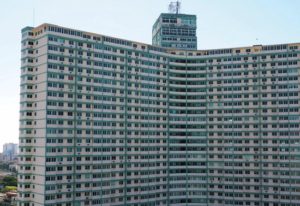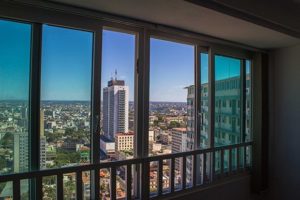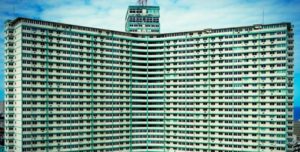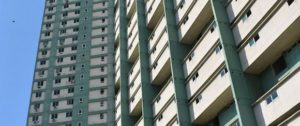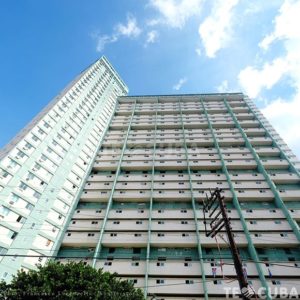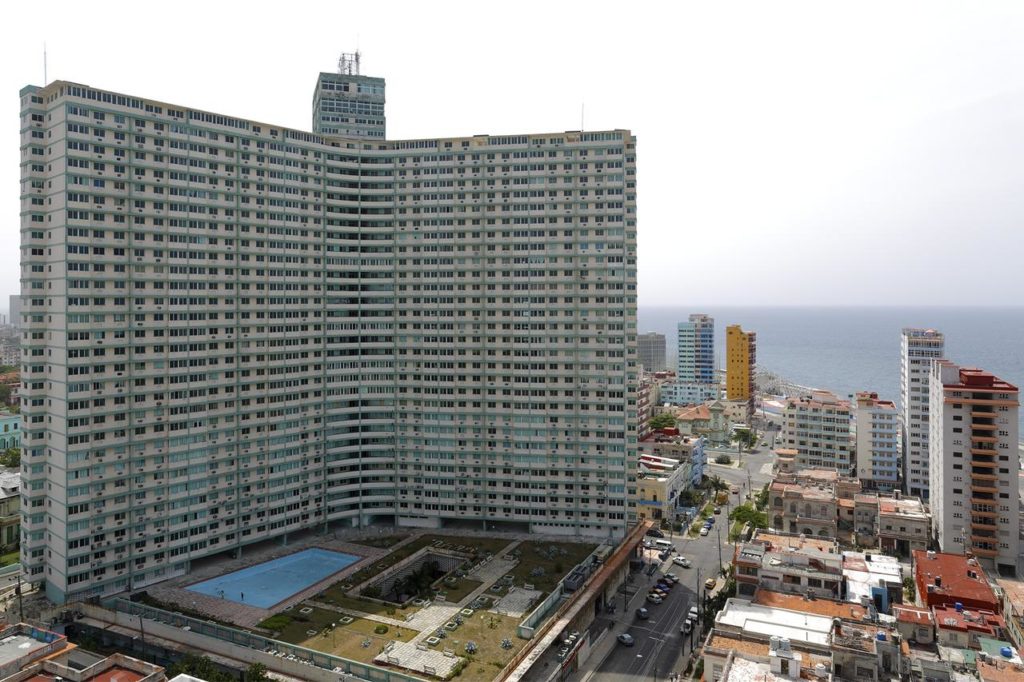 EL EDIFICIO FOCSA EN LA HABANA, SEPTIMA MARAVILLA DE LA INGENIERÍA CUBANA.
EL EDIFICIO FOCSA EN LA HABANA, SEPTIMA MARAVILLA DE LA INGENIERÍA CUBANA.
Para resumir las siete maravillas de la Ingeniería Civil Cubana explicamos que ellas son: el acueducto de Albear, el túnel de la bahía y el sifón del alcantarillado bajo la propia ensenada capitalina. Conforman también ese grupo maravilloso el puente de Bacunayagua, entre las provincias de La Habana y Matanzas, la carretera Central y el viaducto de La Farola, que cortó en dos el intrincado macizo montañoso de Sagua-Baracoa. La séptima maravilla de la ingeniería civil cubana es el edificio Focsa.
Con sus 39 niveles desde el cimiento a la torre y 10 000 metros cuadrados de superficie, el Focsa se alza majestuoso en la manzana enmarcada por las calles M, N, 17 y 19, en la barriada habanera de El Vedado. Su construcción comenzó en febrero de 1954 y se concluyó en junio de 1956. Lo que equivale a decir que entre la colocación de la primera piedra del edificio y el último brochazo que se dio a sus paredes transcurrieron 28 meses.
Desde finales de 1952, Goar Mestre, propietario de CMQ Radio y Televisión, se empeñó en construir un edificio de apartamentos para sus artistas y empleados. Para hacerlo adquirió, por 700 000 pesos, el terreno del club Cubanaleco, de los trabajadores de la Compañía Cubana de Electricidad, y creó la Compañía de Fomento de Obras y Construcciones S A. Sus siglas darían nombre al edificio.
Los tres hermanos Mestre, Goar, Abel y Luis Augusto, se asociaron en el negocio. Se sumaron además Pepín Bosch, de la casa ronera Bacardí, y, entre otros, Ernesto Gómez Sampera, que fungió como vicepresidente segundo y que fue el proyectista y arquitecto de la obra. Julián de Zulueta, propietario y presidente del Banco Continental, tenía intereses ocultos en la Compañía de Fomento de Obras y Construcciones S A. Los financió con dinero de su entidad bancaria. Lo que puso al Banco Continental al filo de la quiebra y provocó que el Banco Nacional de Cuba lo interviniera en 1955.
El Focsa mide 121 metros sobre el nivel de la calle. En el momento de su inauguración fue el inmueble de hormigón más alto del mundo, superado solo por el edificio Marinelli, de Sao Paulo, en Brasil, con sus 144 metros de altura.
Muchas fueron las opiniones en contra de un edificio tan alto. Se dijo que sus vibraciones y oscilaciones podrían ser dañinas para la salud humana, y que su estructura de hormigón lo haría antieconómico a partir del piso 18. Ni lo uno ni lo otro. Las investigaciones demostraron que en caso de que vientos de 240 km/h azotaran al Focsa, su parte superior podría moverse no más de diez centímetros, lo que no resultaba significativo para la salud ni para el inmueble mismo. Y en cuanto a los costos, el ahorro fue de 5% en los pisos bajos y de 18% en los altos.
El Focsa tiene forma de “Y” y consta de tres partes fundamentales. En la primera de ellas, el basamento, hallan espacio tiendas, estudios de TV, una agencia bancaria y otra de publicidad, oficinas, restaurantes, cafeterías, una farmacia, un teatro, un night club…
La segunda es una torre de 29 pisos. Veintiocho de esos pisos se destinan a apartamentos de tres o cuatro habitaciones, incluida una habitación para el personal de servicio. En el piso 29 hay siete pent-houses, que complementan los 373 apartamentos del inmueble. En la parte más alta del Focsa se encuentra el restaurante La Torre, con buena oferta de cocina internacional, variada coctelería y excelente carta de vinos. Es una atalaya encristalada desde donde pueden verse hasta los barrios periféricos de La Habana.
Forman parte asimismo de la edificación parques y jardines interiores, y parqueos soterrados. Cuenta además con piscina propia.
El Focsa fue concebido para que vivieran y laboraran en sus áreas unas 5 000 personas. En su concepción se superó el concepto aislacionista de las grandes mansiones de los años 20, que eludía la trama urbana como ámbito de vida. Se trata de una unidad vecinal que pasó a ser el primer exponente habanero de una ciudad dentro de la ciudad, de una isla habitada y autosuficiente, equipada con todos los servicios sociales. Se calcula que su inversión total fue de diez millones de pesos.
El Focsa constituyó una operación inmobiliaria fenomenal. La mayor y más ventajosa operación de venta de inmuebles que se ejecutó en Cuba en todos los tiempos. Cuando se dio fin a la obra, en junio del 56, se habían vendido ya locales por un millón de pesos y se habían recuperado tres millones por la venta de apartamentos. En octubre de 1957, esto es, dieciséis meses después de la conclusión del edificio, estaban vendidos todos sus locales para oficinas y comercios y la totalidad de sus apartamentos.
Los apartamentos de tres habitaciones se vendieron en 17 500 pesos, y los de cuatro habitaciones, en 21 500. Sumas que hoy podrán parecer poco significativas si de inmuebles se trata, pero que eran cantidades nada desdeñables en la época.
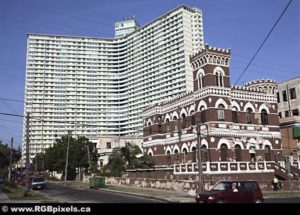 THE FOCSA BUILDING IN HAVANA, SEVENTH WONDER OF CUBAN ENGINEERING.
THE FOCSA BUILDING IN HAVANA, SEVENTH WONDER OF CUBAN ENGINEERING.
To summarize the seven wonders of Cuban Civil Engineering we explain that they are: the Albear aqueduct, the bay tunnel and the sewer siphon under the capital’s own cove. This wonderful group is also made up of the Bacunayagua bridge, between the provinces of Havana and Matanzas, the Central highway and the La Farola viaduct, which cut the intricate mountain mass of Sagua-Baracoa in two. The seventh wonder of Cuban civil engineering is the Focsa building.
With its 39 levels from the foundation to the tower and 10,000 square meters of surface, the Focsa stands majestically on the block framed by M, N, 17 and 19 streets, in the Havana neighborhood of El Vedado. Its construction began in February 1954 and was completed in June 1956. Which is to say that 28 months passed between the laying of the first stone of the building and the last brush stroke on its walls.
Since the end of 1952, Goar Mestre, owner of CMQ Radio y Televisión, has been trying to build an apartment building for his artists and employees. To do so, it acquired, for 700,000 pesos, the land of the Cubanaleco club, from the workers of the Cuban Electricity Company, and created the Company for the Promotion of Works and Constructions S.A. Its initials would give the building its name.
The three Mestre brothers, Goar, Abel and Luis Augusto, were associated with the business. Pepín Bosch, from the Bacardi rum house, and, among others, Ernesto Gómez Sampera, who served as second vice president and who was the designer and architect of the work, also joined. Julián de Zulueta, owner and president of Banco Continental, had hidden interests in the Compañía de Fomento de Obras y Construcciones S A. He financed them with money from his bank. This put Banco Continental on the brink of bankruptcy and caused Banco Nacional de Cuba to intervene in 1955.
The Focsa is 121 meters above the street level. At the time of its inauguration, it was the tallest concrete building in the world, surpassed only by the Marinelli building, in Sao Paulo, Brazil, at 144 meters high.
There were many opinions against such a tall building. It was said that its vibrations and oscillations could be harmful to human health, and that its concrete structure would make it uneconomic from the 18th floor. Neither. Investigations showed that if winds of 240 km / h hit Focsa, its upper part could move no more than ten centimeters, which was not significant for health or for the property itself. And in terms of costs, savings were 5% in the lower floors and 18% in the upper ones.
The Focsa has a “Y” shape and consists of three fundamental parts. In the first one, the basement, there are shops, TV studios, a bank, and an advertising agency, offices, restaurants, cafes, a pharmacy, a theater, a night club …
The second is a 29-story tower. Twenty-eight of those floors are for three- or four-bedroom apartments, including a room for service personnel. On the 29th floor, there are seven penthouses, which complement the 373 apartments of the property. In the highest part of the Focsa is the La Torre restaurant, with a good offer of international cuisine, varied cocktails, and an excellent wine list. It is a glazed watchtower from where you can see even the peripheral neighborhoods of Havana.
Parks and interior gardens and underground parking are also part of the building. It also has its own pool.
The Focsa was conceived so that some 5,000 people lived and worked in its areas. In its conception, the isolationist concept of the great mansions of the 1920s, which eluded the urban fabric as a sphere of life, was overcome. It is a neighborhood unit that became the first exponent of a city within the city, of an inhabited and self-sufficient island, equipped with all social services. His total investment is estimated to be ten million pesos.
Focsa was a phenomenal real estate operation. The largest and most advantageous real estate sale operation that has been carried out in Cuba at all times. When the work was completed in June 56, premises had already been sold for one million pesos and three million had been recovered from the sale of apartments. In October 1957, that is, sixteen months after the completion of the building, all of its office and retail space and all of its apartments were sold.
The three-room apartments were sold for 17,500 pesos, and the four-room apartments for 21,500. Sums that may seem insignificant today if they are real estate, but they were not insignificant amounts at the time.
Agencies/ RHC/ Ciro Bianchi/ Lorena Viñas/ Internet/CubaDebate Photos/ Arnoldo Varona/ www.TheCubanHistory.com
THE CUBAN HISTORY, HOLLYWOOD.



